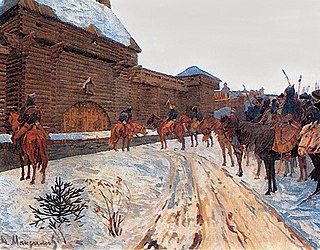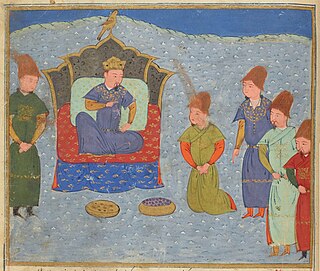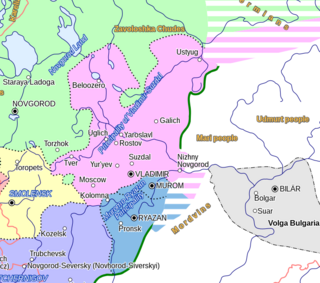
Year 1237 (MCCXXXVII) was a common year starting on Thursday of the Julian calendar.

Vsevolod I Yaroslavich, ruled as Grand Prince of Kiev from 1078 until his death.

The Mongol Empire invaded and conquered Kievan Rus' in the mid-13th century, destroying numerous cities including the largest such as Kiev and Chernigov. The Mongol siege and sack of Kiev in 1240 is generally held to mark the end of Kievan Rus'. Many other major Rus' principalities and urban centres in the northwest escaped destruction or suffered little to no damage from the Mongol invasion, including the Novgorod Republic, Pskov, Smolensk, Polotsk, Vitebsk, and probably Rostov and Uglich.

The Golden Horde, self-designated as Ulug Ulus, lit. 'Great State' in Turkic, was originally a Mongol and later Turkicized khanate established in the 13th century and originating as the northwestern sector of the Mongol Empire. With the disintegration of the Mongol Empire after 1259, it became a functionally separate khanate. It is also known as the Kipchak Khanate or as the Ulus of Jochi, and it replaced the earlier, less organized Cuman–Kipchak confederation.

Batu Khan was a Mongol ruler and founder of the Golden Horde, a constituent of the Mongol Empire. Batu was a son of Jochi, thus a grandson of Genghis Khan. His ulus ruled over the Kievan Rus', Volga Bulgaria, Cumania, and the Caucasus for around 250 years.

Vladimir-Suzdal, formally known as the Principality of Vladimir-Suzdal or Grand Principality of Vladimir (1157–1331), also as Vladimir-Suzdalian Rus', was one of the major principalities that succeeded Kievan Rus' in the late 12th century, centered in Vladimir-on-Klyazma. With time the principality grew into a grand principality divided into several smaller principalities. After being conquered by the Mongol Empire, the principality became a self-governed state headed by its own nobility. A governorship of principality, however, was prescribed by a jarlig issued from the Golden Horde to a Rurikid sovereign.
Yaroslav II Vsevolodovich, also transliterated as Iaroslav, was Grand Prince of Vladimir from 1238 to 1246. He helped to restore his country and capital after the Mongol invasion.

Saint Michael of Chernigov or Mikhail Vsevolodovich was a Rus' prince. He was grand prince of Kiev, 1236–1240, 1240, 1241–1243); and he was also prince of Pereyaslavl (1206), of Novgorod-Seversk (1219–1226), of Chernigov, of Novgorod, and of Halych (1235–1236).
The Berendei or Berindei were a medieval Turkic tribe, most likely of Kipchak origin. They were part of the tribal confederation of the "peak caps" or the "black hats".

Ryazan, capital of the Principality of Ryazan, was the first Russian city to be besieged by the Mongol invaders under Batu Khan.
The Principality of Ryazan, later known as the Grand Principality of Ryazan, was a principality from 1129 to 1521. Its capital was the city of Ryazan, now known as Old Ryazan, which was destroyed in 1237 during the Mongol invasions. The capital was moved to Pereyaslavl-Ryazansky, later renamed Ryazan.

The Council of Liubech was one of the best documented princely meetings in Kievan Rus' that took place in Liubech in 1097. The council ended the Chernihiv war of succession (1093–1097) between Sviatopolk II of Kiev, Vladimir II Monomakh and Oleg I of Chernigov who fought for the heritage of his father Sviatoslav II of Kiev.
Oleg III Svyatoslavich was a Kievan Rus' prince. His baptismal name was Feodosy. He was prince of Vshchizh, of Novgorod-Seversk (1200–1201), and of Chernigov (1201/1202–1204).
The Metropolis of Kiev and all Rus' was a metropolis of the Eastern Orthodox Church that was erected on the territory of Kievan Rus'. It existed between 988 AD and 1596 AD. Canonically, it was under the jurisdiction of the Ecumenical Patriarchate of Constantinople. The episcopal seat (cathedra) was located in the city of Kiev.

During the Mongol Invasion of Rus, the Principality of Ryazan was the first to be attacked.

Yuri Igorevich also known as Yuriy Ingvarevich, was Grand Prince of Ryazan from 1235 to 1237, during the Mongol invasion of Rus'.
Following the Battle of Voronezh River in December 1237, Yuri II of Vladimir sent both of his sons with "all his men" and Voivode Yeremey to defend the fortress of Kolomna, which was on the border to the Wild Fields.

The siege of Vladimir was part of the Mongol invasion of Rus.

The siege of Moscow was part of Mongol invasion of Rus.
The sack of Chernigov occurred during the westward expansion of the Mongol Empire. It was part of the 1237–1242 Mongol invasion of Rus'. The siege and capture of the capital of the Chernigov Principality by the Mongols occurred on October 18, 1239.









